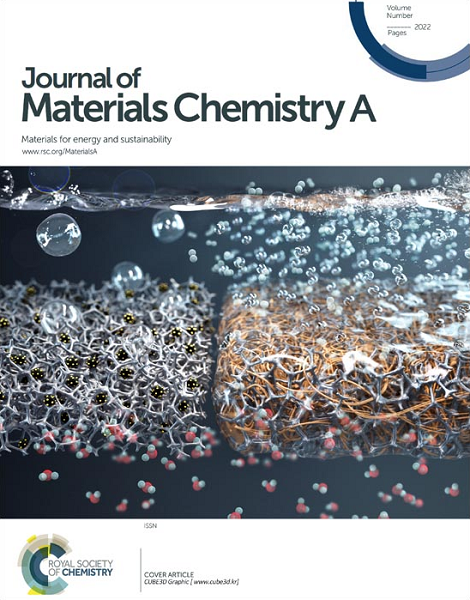Pt(II)作为活性位点负载在超亲水性泡沫镍上,提高了电催化析氢性能
IF 10.7
2区 材料科学
Q1 CHEMISTRY, PHYSICAL
引用次数: 0
摘要
在寻找一种可行的电能氢转化技术的过程中,电化学析氢反应(HER)有望成为未来的发展方向。然而,为该系统合理设计高活性和耐用的电催化剂仍然是一个挑战。在这里,我们引入了负载在无粘结剂的超亲水性泡沫镍(NiF(H))上的Pt(II)作为HER电催化剂。我们发现,Pt(II)/NiF(H)表面的超亲水层增强了氢泡从电极表面的分离,也降低了Volmer和Heyrovsky台阶产生的电阻。原位拉曼光谱结果表明,Pt(II)/NiF(H)能有效加速水的吸附和解离过程。密度泛函理论(DFT)计算表明,Pt(II)/NiF(H)表面可以有效地将无氢吸附能调整到一个有利的值,从而提高HER活性。此外,超亲水性层作为一个平台,可以在长期的HER过程中充分稳定Pt(II)物种。Pt(II)/NiF(H)催化剂比商业Pt/C(20%)和其他对照样品更活跃,表现出26 mV的小过电位(η),驱动电流密度为10 mA cm-2。此外,Pt(II)/NiF(H)在过电位100 mV下达到8.9 A mgPt-1的高质量活性,表明Pt的利用率很高。本工作为合理设计先进的高价态Pt基HER电催化剂提供了可行的建设性指导。本文章由计算机程序翻译,如有差异,请以英文原文为准。
Pt(II) as an active site supported on superhydrophilic nickel foam with boosted electrocatalytic hydrogen evolution performance
In the search for a viable power to hydrogen conversion technology, the electrochemical hydrogen evolution reaction (HER) promises to be the future. However, the rational design of highly active and durable electrocatalysts for this system remains a challenge. Here, we introduce Pt(II) species supported on binder-free superhydrophilic nickel foam (NiF(H)) as an HER electrocatalyst. We show that the superhydrophilic layer on the surface of Pt(II)/NiF(H) enhances the detachment of hydrogen bubbles from the surface of the electrode and also decreases the resistances emanating from the Volmer and Heyrovsky steps. In-situ Raman spectra results indicate that Pt(II)/NiF(H) can effectively accelerate water adsorption and dissociation steps. Density functional theory(DFT) calculations demonstrate that the surface of Pt(II)/NiF(H) can effectively tune the hydrogen adsorption-free energy to a favorable value, improving the HER activity. In addition, the superhydrophilic layer acts as a platform that can fully stabilize the Pt(II) species in the long-term HER process. The Pt(II)/NiF(H) catalyst is more active than a commercial Pt/C(20%) and other control samples, exhibiting a small overpotential (η) of 26 mV to drive a current density of 10 mA cm-2. In addition, the Pt(II)/NiF(H) achieves high mass activities of 8.9 A mgPt-1 at overpotentials of 100 mV, indicating a high utilization of Pt. This work provides a feasible constructive guideline for the rational design of an advanced high-valence-state Pt-based electrocatalyst for HER.
求助全文
通过发布文献求助,成功后即可免费获取论文全文。
去求助
来源期刊

Journal of Materials Chemistry A
CHEMISTRY, PHYSICAL-ENERGY & FUELS
CiteScore
19.50
自引率
5.00%
发文量
1892
审稿时长
1.5 months
期刊介绍:
The Journal of Materials Chemistry A, B & C covers a wide range of high-quality studies in the field of materials chemistry, with each section focusing on specific applications of the materials studied. Journal of Materials Chemistry A emphasizes applications in energy and sustainability, including topics such as artificial photosynthesis, batteries, and fuel cells. Journal of Materials Chemistry B focuses on applications in biology and medicine, while Journal of Materials Chemistry C covers applications in optical, magnetic, and electronic devices. Example topic areas within the scope of Journal of Materials Chemistry A include catalysis, green/sustainable materials, sensors, and water treatment, among others.
 求助内容:
求助内容: 应助结果提醒方式:
应助结果提醒方式:


